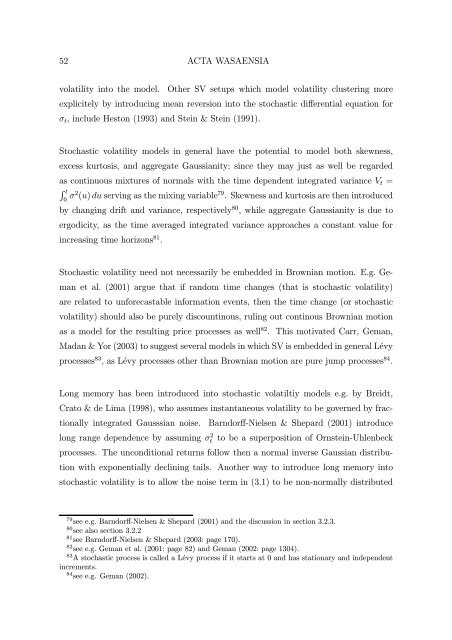BERND PAPE Asset Allocation, Multivariate Position Based Trading ...
BERND PAPE Asset Allocation, Multivariate Position Based Trading ...
BERND PAPE Asset Allocation, Multivariate Position Based Trading ...
Create successful ePaper yourself
Turn your PDF publications into a flip-book with our unique Google optimized e-Paper software.
52 ACTA WASAENSIAvolatility into the model. Other SV setups which model volatility clustering moreexplicitely by introducing mean reversion into the stochastic differential equation forσ t , include Heston (1993) and Stein & Stein (1991).Stochastic volatility models in general have the potential to model both skewness,excess kurtosis, and aggregate Gaussianity; since they may just as well be regardedas continuous mixtures of normals with the time dependent integrated variance V t = t0 σ2 (u) du serving as the mixing variable 79 . Skewness and kurtosis are then introducedby changing drift and variance, respectively 80 , while aggregate Gaussianity is due toergodicity, as the time averaged integrated variance approaches a constant value forincreasing time horizons 81 .Stochastic volatility need not necessarily be embedded in Brownian motion. E.g. Gemanet al. (2001) argue that if random time changes (that is stochastic volatility)are related to unforecastable information events, then the time change (or stochasticvolatility) should also be purely discountinous, ruling out continous Brownian motionas a model for the resulting price processes as well 82 . This motivated Carr, Geman,Madan & Yor (2003) to suggest several models in which SV is embedded in general Lévyprocesses 83 ,asLévy processes other than Brownian motion are pure jump processes 84 .Long memory has been introduced into stochastic volatiltiy models e.g. by Breidt,Crato & de Lima (1998), who assumes instantaneous volatility to be governed by fractionallyintegrated Gausssian noise. Barndorff-Nielsen & Shepard (2001) introducelong range dependence by assuming σt2 to be a superposition of Ornstein-Uhlenbeckprocesses. The unconditional returns follow then a normal inverse Gaussian distributionwith exponentially declining tails. Another way to introduce long memory intostochastic volatility is to allow the noise term in (3.1) to be non-normally distributed79 see e.g. Barndorff-Nielsen & Shepard (2001) and the discussion in section 3.2.3.80 see also section 3.2.281 see Barndorff-Nielsen & Shepard (2003: page 170).82 see e.g. Geman et al. (2001: page 82) and Geman (2002: page 1304).83 A stochastic process is called a Lévy process if it starts at 0 and has stationary and independentincrements.84 see e.g. Geman (2002).
















